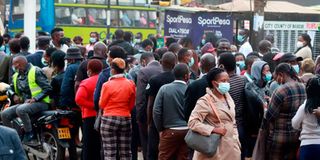PSVs carrying below capacity grave danger

Nairobi residents queue on Latema Road as they wait to board matatus on January 21, 2021.
What you need to know:
- Air pollution is responsible for a substantial share of respiratory system complications.
- Studies show vehicular emissions are a key cause of pollution in Nairobi and other major towns in Kenya.
The government directive for public service vehicles (PSVs) to carry 60 per cent of their capacity has not only placed an extra burden on struggling Kenyans, but is also a threat to health.
The directive, in place since April last year, as a measure to curb the spread of Covid-19, pushed PSVs operators to hike the fare by more than 50 per cent to compensate for the empty seats.
The noble intention is, from an environmental perspective, doing more harm than good to air quality, especially in cities and towns.
Supposing the number of people who travel daily to and from Nairobi’s CBD, for example, is the same as before the pandemic. It means that either matatu saccos have increased vehicles or are making more trips to cater for the high demand. That means more trips, hence increased air pollution.
Social distancing
Walk along Tom Mboya Street in Nairobi’s CBD in the evening and you will encounter long queues of commuters waiting to board matatus. It takes 30 minutes to travel from the CBD to Githurai 45 via Thika Superhighway but passengers spend over an hour in the queue — with no social distancing. Is it not prudent to allow PSVs to carry to full capacity?
It is mind-boggling that, in the SGR trains, passengers sit squeezed and facing each other for about seven hours between Nairobi to Mombasa. The trains carry full capacity.
Political rallies, too, have no social distancing.
The “Global Air 2020” report shows that ambient air pollution was responsible for around 5,000 premature deaths in Kenya in 2019 alone. Economic survey reports being released yearly by Kenya National Bureau of Statistics (KNBS) indicate that the number of people seeking medication for respiratory diseases has been increasing every year.
In 2019 alone, about 22 million people sought medication for diseases of the respiratory system in public health facilities across the country, according to the “Economic Survey 2020” report.
Air pollution is responsible for a substantial share of respiratory system complications.
Traffic jams
Studies show vehicular emissions are a key cause of pollution in Nairobi and other major towns in Kenya. The black carbon from the incomplete fuel combustion, especially produced by older vehicles, forms a large fraction of particulate matter, whose levels in Nairobi are among the highest.
A UN Environment report found that engine idling, which is banned in some parts of the world even in traffic jams, is rampant in Nairobi and other major towns.
Besides, idling engines send millions of small, harmful, polluting particles into the air, which, according to the World Health Organization (WHO), can lodge deep inside the lungs.
WHO estimates that 19,000 people die prematurely from air pollution in Kenya every year.
The government should allow PSVs to carry full capacity to save our lungs.





